
1
Emu at the Pinnacles
On entering the Pinnacles we surprised an Emu which was strolling between the Pinnacle formations. The Emu (centre) blends in with surrounding colours.
| 
2
The Emu walks towards the Bush
Nambung National Park.
| 
3
Rear view of the Emu
Nambung National Park.
|

4
Emu glances back at Camera
Nambung National Park.
| 
5
Emu strides away
Nambung National Park.
| 
6
Galah perched on a Pinnacle
Nambung National Park.
|

7
Pinnacles come in many shapes and sizes
In the Pinnacles Desert, in the heart of Nambung National Park, thousands of huge limestone pillars rise out of a stark landscape of yellow sand.
| 
8
Galah keeping watch over Pinnacles
In places the Pinnacles reach up to three and a half metres tall.
| 
9
Pinnacles formations large and small
Some are jagged, sharp-edged columns, rising to a point; while others resemble tombstones.
|

10
The Pinnacles of Nambung National Park
Three old systems of sand dunes run parallel to the WA coast, marking ancient shorelines.
| 
11
The Pinnacles
The oldest of these, known as the Spearwood dune system, is characterised by yellow or brownish sands.
| 
12
The Pinnacles
In winter, rain, which is slightly acidic, dissolves small amounts of calcium carbonate as it percolates down through the sand.
|

13
Texture of the Pinnacles
As the dune dries out during summer, this is precipitated as a cement around grains of sand in the lower levels of the dunes, binding them together and eventually producing a hard limestone rock.
| 
14
Textures of the Pinnacles
At the same time, vegetation that became established on the surface, aided this process.
| 
15
The Pinnacles
Plant roots stabilised the surface and encouraged a more acidic layer of soil and humus (containing decayed plant and animal matter) to develop over the remaining quartz sand.
|

16
The Pinnacles
The acidic soil accelerated the leaching process, and a hard layer of calcrete formed over the softer limestone below.
| 
17
The Pinnacles
Cracks which formed in the calcrete layer were exploited by plant roots.
| 
18
The Pinnacles
When water seeped down along these channels, the softer limestone beneath was slowly leached away and the channels gradually filled with quartz sand.
|

19
The Pinnacles in Morning Sun
This subsurface erosion continued until only the most resilient columns remained.
| 
20
The Pinnacles in Morning Sun
The Pinnacles, then, are the eroded remnants of the formerly thick bed of limestone.
| 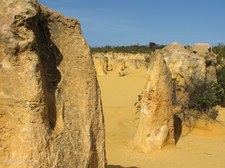
21
The Pinnacles in Morning Sun
As bush fires denuded the higher areas, south-westerly winds carried away the loose quartz sands and left these limestone pillars standing up to three and a half metres high.
|

22
Sedge growing at base of Pinnacle
Although the formation of the Pinnacles would have taken many thousands of years, they were probably only exposed in quite recent times.
| 
23
Lit by the Morning Sun
Aboriginal artefacts at least 6,000 years old have been found in the Pinnacles Desert despite no recent evidence of Aboriginal occupation.
| 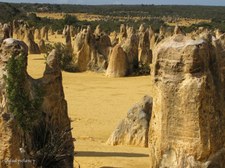
24
Seemingly endless Pinnacles
This tends to suggest that the Pinnacles were exposed about 6,000 years ago and then covered up by shifting sands, before being exposed again in the last few hundred years.
|

25
Shaped by the Winds
This process can be seen in action today - with the predominantly southerly winds uncovering pinnacles in the northern part of the Pinnacles Desert but covering those in the south.
| 
26
A Pinnacle is Born
The shifting sands uncover the top of a Pinnacle previously buried in the sand.
| 
27
Limestone Formation
Over time, the limestone spires will no doubt be covered again by other sand drifts and the cycle repeated, creating weird and wonderful shapes over and over again.
|

28
The Pinnacles Desert
Nambung National Park.
| 
29
Sands of Time
| 
30
Sculptured by Nature
|

31
Pinnacles large and small
| 
32
Nature's creation
| 
33
Standing in the Desert
|

34
Pinnacles to the Horizon
| 
35
The Pinnacles Desert
| 
36
Life in the Desert
|

37
Distant Views over the Pinnacles
| 
38
Distant Views over the Pinnacles
| 
39
Distant Views over the Pinnacles
|

40
Indian Ocean in the Distance
Nambung National Park.
| 
41
White Sand Dunes and Indian Ocean
Nambung National Park.
| 
42
Ocean views from The Pinnacles
Nambung National Park.
|

43
White Sand Dunes in the Distance
Nambung National Park.
| 
44
White Sand Dunes
Nambung National Park.
| 
45
View over the Pinnacles
Nambung National Park.
|

46
The Pinnacles
Nambung National Park.
| 
47
Pinnacles to the Horizon
Nambung National Park.
| 
48
Vapour Trail above Sand Dune
Nambung National Park.
|

49
Pinnacles Landscape
| 
50
Pinnacles Landscape
| 
51
Pinnacles Landscape
|

52
Moving Sands encroaching on these Pinnacles
| 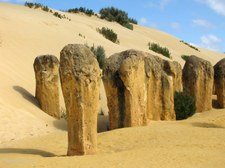
53
This Sand Dune will eventually cover these Pinnacles
| 
54
Pinnacles waiting to be re-buried by Sand
|

55
Hollowed sand at base of Pinnacle
Swirling Sands create hollows around the base of the Pinnacles.
| 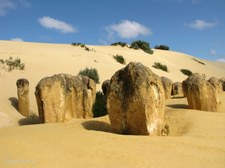
56
Approaching Sand Dune
| 
57
Only a matter of time before these are buried in Sand
|

58
Pinnacle partly buried in Sand
| 
59
Pinnacle formation
| 
60
Standing in the Shifting Sand
|

61
Gap between Pinnacles
| 
62
Pinnacle with Hole
| 
63
Gap between Pinnacles
|

64
Short with Rounded Cap
| 
65
In the Path of approaching Sand Dune
| 
66
Life against the Rocks
Cutleaf Hibbertia (Hibbertia cuneiformis)
|

67
Hollow made by the Swirling Wind
Swirling winds create hollows in the sand around the base of the Pinnacles.
| 
68
Morning Sun on the Pinnacles
This particular group were in the shadow of the sand dune on the previous late afternoon tour.
| 
69
Morning Sun on the Pinnacles
|

70
Tracks in the Sand
| 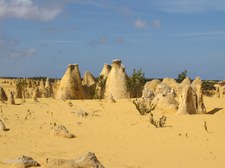
71
Approaching "The Milkbottles"
These unusual shaped Pinnacles are known as "The Milkbottles".
| 
72
"The Milkbottles"
|

73
"The Milkbottles"
| 
74
Other Pinnacles near "The Milkbottles"
| 
75
"The Milkbottles"
|

76
"The Milkbottles"
| 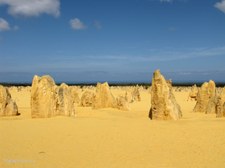
77
Desert Sands
| 
78
Pinnacles in Desert Sands
|

79
Sentinels of the Desert
| 
80
Sentinels of the Desert
| 
81
Sentinels of the Desert
This location was used for my Sunset photos in the previous album.
|

82
Shapes and Textures of the Pinnacles
| 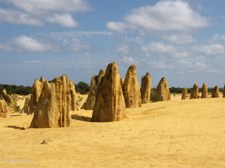
83
The Pinnacles
| 
84
Westward View
Location used for Sunset Photos in previous album.
|

85
Sunset location by Day
Location used for Sunset Photos in previous album. Those dead twigs were used as a foreground.
| 
86
Daytime view of Sunset Location
Location used for Sunset Photos in previous album. Those dead twigs were used as a foreground.
| 
87
Pinnacles from an elevated location
|

88
Many of the smaller Pinnacles
| 
89
Pinnacles Landscape
| 
90
The Pinnacles Desert
|

91
View from higher Location
Nambung National Park.
| 
92
Zoomed to Indian Ocean
| 
93
Distant View
|

94
Nambung National Park
| 
95
Small Pinnacles
| 
96
Galah on Sentry Duty
|

97
Galah (Cacatua roseicapilla)
| 
98
Vegetation around Pinnacles
| 
99
Formation shaped like a Platypus
|

100
A Fallen Pinnacle
| 
101
Galah (Cacatua roseicapilla)
| 
102
Galah (Cacatua roseicapilla)
|

103
Looking back at Galah on Pinnacle
| 
104
Kangaroo-shaped Formation
| 
105
Other side of Kangaroo-shaped formation
|

106
Pinnacle with a peep-hole
| 
107
Overlooking the Pinnacles
| 
108
Last glance at the Pinnacles Desert
|

109
Plaque at Pinnacles Desert Discovery
By day or by night, in the still of a midsummer's afternoon or braced against whipping coastal winds, at ground level or soaring above, the Pinnacles Desert is a unique but constantly changing place. This display allows you to experience the Pinnacles Desert in all its diversity. Explore its sights and sounds, its past and its present; attune your senses to its many moods and marvels.
| 
110
Mike from 'Turquoise Coast Enviro Tours'
Thankyou Mike for an excellent tour of the fascinating Pinnacles Desert.
| 
111
Mike's Dashboard Mascots
An Echidna and a Thorny Devil.
|

112
Pinnacles Panorama 1
Images 43 & 44 stitched.
| 
113
Pinnacles Panorama 2
Images 89 & 90 stitched.
| 
114
Pinnacles Panorama 3
Images 37 & 38 stitched.
|

115
Pinnacles Panorama 4
Images 38 & 39 stitched.
| |